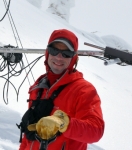The Gallatin National Forest Avalanche Center (GNFAC) came to life during the winter of 1990/91, 21years ago.
Blog List



It hadn’t snowed in days. I was out skiing and digging snowpits, testing the stability. Layers were bonding to one another and I couldn’t find any trouble in the snowpack. But I wasn’t happy.

The winter of 2009/10 was the busiest season the Gallatin National Forest Avalanche Center has had in its twenty years of operation - 87 avalanche incidents were reported in southwest Montana. The incidents reported included 21 people caught, 9 partial burials, 3 full burials and 3 fatalities, but this is, unfortunately, not the full picture. Inherently, many avalanche events were never reported to the forecast center.

Ski areas are now open and so are their backcountry access gates. The sidecountry provides great skiing and snowboarding opportunities, but also presents some challenges.

In 2005, after 16 years of use, the U.S. and Canadian professional avalanche community decided the danger scale needed to be revised. Words like "probable" were confusing, and the scale was weighted toward probability instead of consequence.

This winter, the Climate Prediction Center is predicting a La Nina (the girl) weather pattern, which should bring colder temperatures and more snow to western Montana.

Karl Birkeland1, Ron Johnson2, and Scott Schmidt3
Abstract
By Karl Birkeland and Cary Mock. Published in 1996 in Mountain Research and Development, 16(3), 281-286.
By Karl Birkeland. Paper presented at the 1998 ISSW, and to be published in the Proceedings of the 1998 ISSW, Sunriver, Oregon.
A Comparison Study of the Shredblock and Rutschblock Snow Stablility Tests by Andy Gleason. Presented at the 1998 ISSW, and to be published in the Proceedings of the 1998 ISSW, Sunriver, Oregon.
The Shredblock test is a field test to measure the relative instability of the snowpack in a backcountry setting with minimal equipment. The Shredblock test is based on the Rutschblock test but uses a snowboard instead of skis to load an isolated column of snow.
Methods

A few years ago I was climbing in the Alaska Range. My partner and I were stuck 26 pitches up the first ascent of a mixed face five days into a seven-day storm. As I looked down the face covered with rockbands, couloirs and pockets of snow....
By Ron Johnson and Karl Birkeland. Paper presented at the 2002 ISSW, and published in the Proceedings of the 2002 ISSW, Penticton, British Columbia.

By Doug Chabot. Paper presented at the 2002 ISSW, and published in the Proceedings of the 2002 ISSW, Penticton, British Columbia.

We just finished our 20th year of operation at the Gallatin National Forest Avalanche Center (GNFAC). All three of us had a great, safe season and owe a huge thanks to all our supporters in the community, co-workers on Gallatin National Forest, and Friends of the Avalanche Center (FOAC). We could not have succeeded without all of your help.

Knowing the tools and skills of safe travel in avalanche terrain is an essential component of making informed decisions in this environment. These tools include having rescue gear and knowing how to use it, understanding avalanche terrain, recognizing signs of instability and making smart choices.

The agility and power of today's snowmobiles allow riders to easily access avalanche terrain with a speed and thrill that makes it easy to overlook noticeable sings of snow instability. Paying attention to clues of instability and knowing how to react to them is a sizeable advantage in staying safe while riding in the backcountry.

I can't believe this is happening. I watch my friend ski a beautiful line, but the slope avalanches in slow motion. It swallows him from behind and I can't see him. I scream, "Avalanche!", but I don't know if he heard me. He's buried. I know it.

Sidecountry is defined as out-of-bounds, backcountry terrain that is accessed from a ski area. The ski lifts make getting to the backcountry easier for everybody and more accessible to the uninitiated, but does not provide any more safety since there is no avalanche control or ski patrol services in the out-of-bounds.
